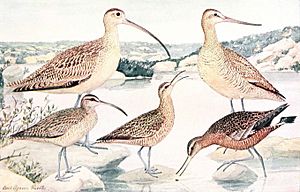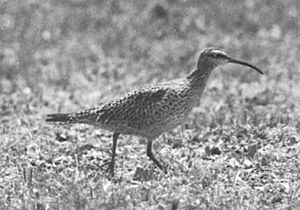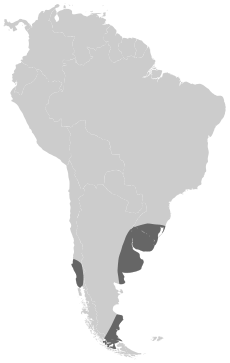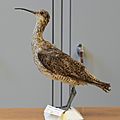Eskimo curlew facts for kids
Quick facts for kids Eskimo curlew |
|
|---|---|
 |
|
| Specimen in Laval University Library | |
| Conservation status | |
| Scientific classification | |
| Genus: |
Numenius
|
| Species: |
borealis
|
 |
|
| Breeding range of Eskimo curlew. Dark blue: known range, blue: probable range, pale blue: potential range. | |
The Eskimo curlew (Numenius borealis), also called the northern curlew, is a type of curlew bird. It belongs to the Scolopacidae family, which includes sandpipers and snipes.
This bird used to be one of the most common shorebirds in the cold, flat lands (tundra) of western Canada and Alaska. Sadly, about two million of these birds were hunted each year in the late 1800s.
Since there hasn't been a reliable sighting since 1987, and no confirmed sighting since 1963, the Eskimo curlew is now thought to be possibly extinct. The bird was about 30 centimeters (12 inches) long. It mainly ate insects and berries.
Contents
Understanding the Eskimo Curlew's Family Tree
The Eskimo curlew is one of eight types of curlew. It is part of the Numenius group of birds. It used to be in its own group called Mesoscolopax.
Numenius birds are part of the Scolopacidae family. This family also includes birds like woodcocks, phalaropes, snipes, and sandpipers. These birds are all part of a larger group called Charadriiformes.
A scientist named Johann Reinhold Forster first described this species in 1772. The name Numenius might come from a Greek word meaning "of the new moon". This is because the bird's thin beak looks a bit like a thin crescent moon. Another idea is that it comes from a word meaning "nod," because the bird often bends its head forward. The word "borealis" is Latin for "northern."
This bird had many common names. People called it the prairie pigeon, fute, little curlew, doe-bird, and doughbird. The last two names came from how fat the birds were when they started their journey south for the winter.
What Did the Eskimo Curlew Look Like?
Eskimo curlews were small curlews. They were about 30 centimeters (12 inches) long and weighed around 360 grams (13 ounces). Their wingspan was about 70 centimeters (28 inches).
Adult birds had long, dark grayish legs and a long beak that curved slightly downwards. Their upper parts were mottled brown, meaning they had patchy brown markings. Their undersides were light brown. When they flew, you could see cinnamon-colored feathers under their wings.
They looked similar to the Hudsonian curlew, which is a type of whimbrel. However, Eskimo curlews were smaller. The easiest way to tell an Eskimo curlew apart was to look at the underside of its main wing feathers. They did not have bars or stripes there. We don't know much about their calls, but they included clear whistling sounds.
The Eskimo curlew is closely related to the Asian little curlew (Numenius minutus). But the Eskimo curlew was a bit bigger, had longer wings, shorter legs, and warmer brown colors in its feathers.
Where Did the Eskimo Curlew Live?
The Eskimo curlew was a bird of the New World, meaning North and South America. These birds nested and raised their young in the tundra regions of western Canada and Alaska.
Eskimo curlews would migrate (travel) to the grasslands (pampas) of Argentina in late summer. They would return north in February. They were once very rare visitors to western Europe, but there have been no recent sightings there. In Britain, there are only four records, all from the 1800s.
Some people believe that Eskimo curlews and American golden plovers were the shorebirds that helped Christopher Columbus realize land was near. This happened after he had been at sea for 65 days on his first voyage. In the 1800s, millions of Eskimo curlews flew from the Yukon and Northwest Territories. They flew east along the northern coast of Canada, then south over the Atlantic Ocean to South America for the winter. When they returned to North America, they would fly north through the Great Plains.
Ecology and Behavior
Diet
Eskimo curlews found food by looking for it and by probing the ground with their long beaks. While migrating south in Canada, they mostly ate berries. During the rest of their migration and in their breeding areas, they ate insects. Snails and other small creatures without backbones were also part of their diet during migration.
Reproduction
Eskimo curlews likely nested in June. Their nests were on the ground in open areas and were hard to find. They built their nests using dried grass or leaves. The eggs were green with brown spots.
We don't know exactly how these birds incubated their eggs. It's not certain if only one parent or both parents sat on the eggs, or how long it took for the eggs to hatch. These birds did not seem to attack anyone who came near their nests. This suggests that their nests were probably far apart from each other.
Why the Eskimo Curlew Almost Vanished
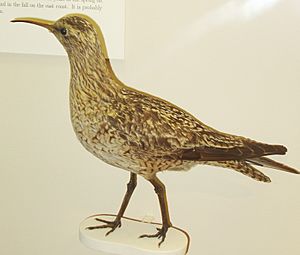
At one time, the Eskimo curlew might have been one of the most common shorebirds in North America. There were millions of them. But by the end of the 1800s, as many as 2 million birds were killed each year.
The last confirmed sightings were in 1962 on Galveston Island, Texas (a photograph was taken), and in Barbados in 1963 (a bird specimen was collected). There was a reliable report of 23 birds in Texas in 1981. There have been a few dozen other reports that could not be confirmed from various places between 1964 and 2006. No confirmed record of this bird has been reported in South America since 1939.
Some experts suggest that we should not call the species extinct yet. They believe we should first check all possible places where the birds might still live. They also suggest that we should consider it "critically endangered (possibly extinct)" for now. Detailed information on all sightings up to 1986 can be found in the online book Eskimo Curlew: A Vanishing Species?.
This species is now fully protected by law in Argentina, Brazil, Canada, Mexico, and the United States. Hunting them has been against the law since around 1916.
Images for kids
-
Specimen in Laval University Library
-
Illustration by John James Audubon
See also
 In Spanish: Zarapito esquimal para niños
In Spanish: Zarapito esquimal para niños



